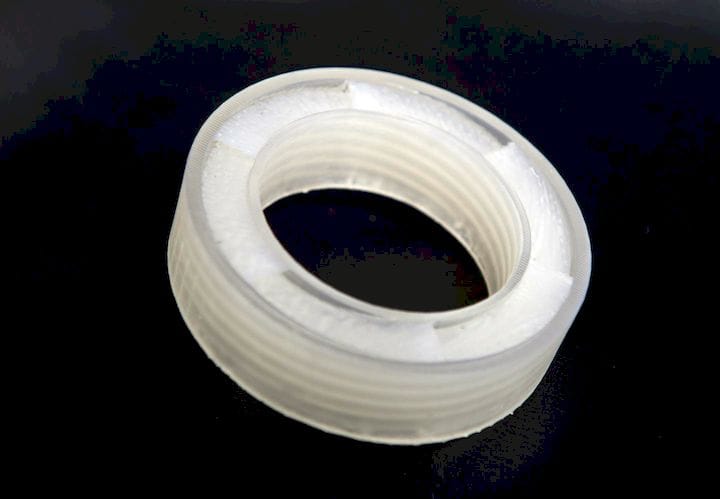![A new technique for 3D printing acoustical metamaterials could spur a new industry [Source: Boston University]](https://fabbaloo.com/wp-content/uploads/2020/05/image-asset_img_5eb09b0679e6d.jpg)
Researchers at Boston University have developed a technique for 3D printing acoustical metamaterials.
Using sophisticated mathematical algorithms they were able to design shapes that could cancel out certain audio frequencies, thus deadening sound.
You can see in this video how their experiment works:
In the experiment, a loudspeaker is placed at one end of the tube. Noisy sound waves travel through the tube and would normally exit through the end of the tube, startling nearby listeners. However, in the experiment a specially designed ring was 3D printed and placed at the end of the tube. In the video you can see how it dramatically reduces the sound level emerging from the tube.
The experimenters found they were able to eliminate 94% of the sound energy produced by the loudspeaker. This is fascinating because the ring is literally open to the air, and you can still see the loudspeaker by peering through the tube.
This is quite a feat of metamaterial design. And if you’re not familiar with metamaterials, they are simply unusual objects with ingenious shapes that generate unexpected functionality. In this case the metamaterial eliminates sound waves.
Some other publications are wildly extrapolating the potential of this technology suggesting, for example, that one might plaster cubicle walls with this stuff, and immediately eliminate all the noise in the workplace. I don’t believe this to be the case at all with this technology.
The experiment they undertook was very carefully designed. The loudspeaker emitted certain known frequencies in a particular direction. The specific design of the deadening ring matched the frequencies emitted by the loudspeaker, thus ensuring it would work.
Really, what they have done here is conclusively prove that it is possible to design a geometric shape that can mostly eliminate specific sound waves.
The problem is that in situations such as open office cubicles, the sound waves that so terribly bother occupants are neither predictable nor coming from specific directions. It is highly unlikely a metamaterial could be designed to eliminate 94% of stray noise in an open office.
It would be possible, however, to design a metamaterial for a given, and fixed, acoustical scenario. For example, suppose an office is next to a workshop, where operating equipment emits a constant and predictable noise. In such a situation it would seem likely that a 3D printed acoustical metamaterial solution could be designed and implemented.
There are no doubt thousands, perhaps even millions, of such situations worldwide.
It seems to me this could be a rather large business opportunity. Imagine a service business where acoustical measurements are taken in an office situation, and a custom acoustical deadening solution is generated by specialized software. This design could then be easily chopped up and 3D printed in smaller parts. The parts could then be installed by the service business into a client’s location.
I could see many such service businesses able to operate in most cities, providing 3D printed acoustical solutions where none where easily obtainable previously.
This could be a whole new industry, and one that might generate significant demand for 3D prints.
Via EurekaAlert











A research thesis details the incredibly complex world of volumetric 3D printing. We review the highlights.